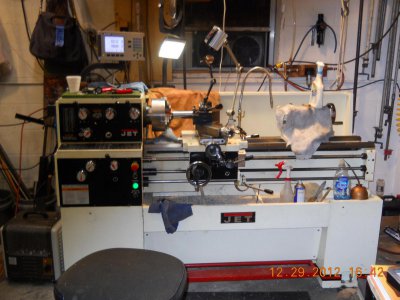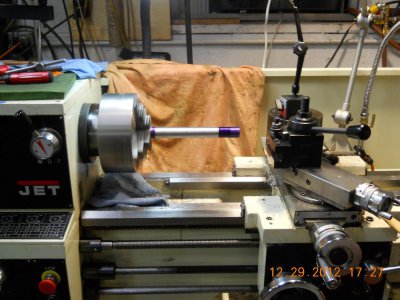- Joined
- Jul 1, 2012
- Messages
- 1,356
I have been thinking all night about a simple method you can do to check head-stock (HS) alignment without but an expensive test bar to put in the spindle nose taper. Chuck up a 1 1/2 to 2 1/2" Bar of alum, leaded cold roll or the best some thick wall tubing. A random length with with about 8" sticking out. First face it, don't worry yet about the face alignment.
Then take a clean up cut of the OD, stop about 1" from chuck, You will want the turned area to be about 6 1/2 to 7" long. The mark n the part 2 areas that we call collars or flange 1/4 to 3/8" wide on the extreme right end then measure 6" toward the chuck and mark another collar or flange 1/4 to 3/8 long, Then go to the right side and turn on the machine, turn clearance say .030" deep between the collars and in the space nearest the chuck to the left of the left collar. __TT________TT
I hope my crude drawing makes sense. That's the top half
of the shaft...Next go to the collars and take .002" cut, on right side.
Lock your cross-slide, after you clean up the right side disengage the feed lever DO NOT TOUCH THE CROSS-FEED or Compound. Let them stay at that position. then hand crank the saddle down to the left and engage the feed to clean up the collar next to the chuck. When the tool clears the edge of the 2nd collar stop the feed and turn off the spindle. Then slowly crank the saddle to the right, dragiing the tool across the collars.
Take a 2nd dry cut..this will eliminate the push away factor. At the end of 2nd cut slowly crank it to the right again to the right and mic the collars. If the head-stock (HS) and bead are aligned it will be the same or slightly bigger .0001" in 6" on tail-stock end.
If it's out, You bed has a twist or the HS is mis-aligned. If it is DON'T Start aligning your head. Let me know and I'll tell you what to do next. I am getting writers cramp...
Then take a clean up cut of the OD, stop about 1" from chuck, You will want the turned area to be about 6 1/2 to 7" long. The mark n the part 2 areas that we call collars or flange 1/4 to 3/8" wide on the extreme right end then measure 6" toward the chuck and mark another collar or flange 1/4 to 3/8 long, Then go to the right side and turn on the machine, turn clearance say .030" deep between the collars and in the space nearest the chuck to the left of the left collar. __TT________TT
I hope my crude drawing makes sense. That's the top half
of the shaft...Next go to the collars and take .002" cut, on right side.
Lock your cross-slide, after you clean up the right side disengage the feed lever DO NOT TOUCH THE CROSS-FEED or Compound. Let them stay at that position. then hand crank the saddle down to the left and engage the feed to clean up the collar next to the chuck. When the tool clears the edge of the 2nd collar stop the feed and turn off the spindle. Then slowly crank the saddle to the right, dragiing the tool across the collars.
Take a 2nd dry cut..this will eliminate the push away factor. At the end of 2nd cut slowly crank it to the right again to the right and mic the collars. If the head-stock (HS) and bead are aligned it will be the same or slightly bigger .0001" in 6" on tail-stock end.
If it's out, You bed has a twist or the HS is mis-aligned. If it is DON'T Start aligning your head. Let me know and I'll tell you what to do next. I am getting writers cramp...


